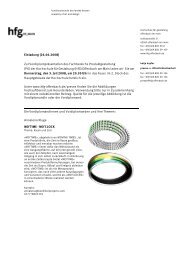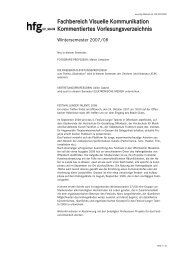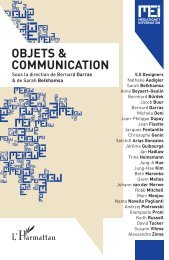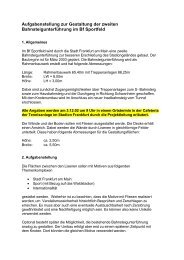Detailliertes Programm - Hochschule für Gestaltung Offenbach
Detailliertes Programm - Hochschule für Gestaltung Offenbach
Detailliertes Programm - Hochschule für Gestaltung Offenbach
Sie wollen auch ein ePaper? Erhöhen Sie die Reichweite Ihrer Titel.
YUMPU macht aus Druck-PDFs automatisch weboptimierte ePaper, die Google liebt.
den relevanten Textsorten gehören Forschungs- und Abenteuerberichte, fachwissenschaftliche Artikel<br />
und Monographien, populärwissenschaftliche Darstellungen, Gedichte und Erzählungen, wobei die<br />
Grenzen zwischen den einzelnen Textsorten häufig ineinander übergehen. Diese Unschärfe wurde von<br />
den Protagonisten (Abenteurer, Wissenschaftler, Schriftsteller, Publikum) mitunter selbst thematisiert<br />
– „Ein seltsames Gemisch von Wahrheit und Dichtung“ – und <strong>für</strong> die eigenen Zwecke<br />
instrumentalisiert.<br />
Die Untersuchung dieser Konkurrenz und der darin implementierten Legitimationsstrategien<br />
veranschaulicht den großen Anteil der auf Bilder gestützten Medialisierung von Forschungen zur<br />
Verwandtschaft von Mensch und Affe <strong>für</strong> die Rezeption der Darwinschen Theorien in der zweiten Hälfte<br />
des 19. Jahrhunderts. Gleichzeitig lässt sich zeigen, wie durch diese in der Öffentlichkeit<br />
ausgetragene Rezeption sowohl innerhalb als auch außerhalb der scientific community ein<br />
bestimmtes Verständnis der Darwinschen Theorien konstruiert wurde, das auch heute virulent ist.<br />
Ann-Sophie Lehmann<br />
Institute for Media and Cultural Studies, University of Utrecht<br />
How to render Jupiter. The interaction of scientific and artistic<br />
processes in the production of photorealistic computer<br />
graphics<br />
In 1978, computer scientist James Blinn developed the first computer generated fly-by animation of<br />
the planet Jupiter for NASA. The short movie, loosely based on visual material gathered by the Voyager<br />
space shuttle was intended to present the public with color images of the planet and broadcasted on<br />
television as real life footage. Blinn used ray tracing to generate his images. In an article describing<br />
the method he writes: “The algorithm was created to model electron density maps of molecular<br />
structures, but it can be used for other artistically interesting shapes”. This statement from one of the<br />
pioneers in the field characterizes the initial position of computer graphics as images in between<br />
scientific and artistic praxis.<br />
This paper wants to analyze the reciprocal relationship in several steps. Looking at the early history<br />
of CG and the Special Interest Group for Graphics (SIGGRAPH), I will analyze how the development of<br />
algorithms in computer science informs the use of photorealistic CG-images in non-scientific contexts.<br />
Vice versa, the paradigm of photorealism in the movie and game sector has influenced the<br />
appearance of scientific imagery, challenging the idea of objective visualization.<br />
Yet not only the application of CG images fuses scientific and artistic motivations. Already at the<br />
developmental stage of CG, scientists obliviously turn to artistic traditions. Using the example of ray<br />
tracing and that of a more recent algorithm to render the appearance of translucent materials like<br />
human skin, it can be shown that scientific analysis preceding the development of algorithms, is<br />
essentially linked to pre-photographic artistic procedures. Thus, scientific CG does not only adhere to<br />
similar visual conventions, also the making of CG follows similar paths of production as artistic<br />
imagery.<br />
Recent media studies have mostly concentrated on the relation between CG and photography;<br />
foregrounding the analogous history of CG and pre-photographic image production and questioning<br />
the art/science dichotomy, helps to establish a more thorough theoretical framework to study the role<br />
of CG in contemporary visual culture.<br />
This research is part of my larger project The brush in the computer. A critical history of computer<br />
graphics and the ‘painterly’ turn in visual culture (financed by the Netherlands Organization for<br />
Scientific Research until 2010).<br />
Vom roten Mars und runden Atomen | HfG <strong>Offenbach</strong> 25-26.10.2007<br />
S. 15




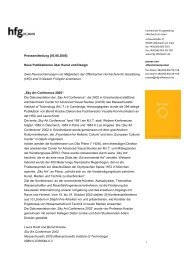
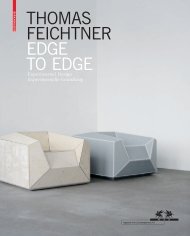
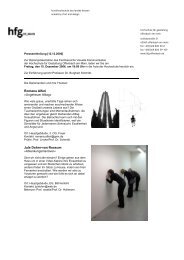

![Einladung [07.02.2006] - Hochschule für Gestaltung Offenbach am ...](https://img.yumpu.com/13375413/1/184x260/einladung-07022006-hochschule-fur-gestaltung-offenbach-am-.jpg?quality=85)

